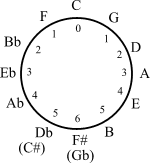Coltrane changes
In jazz harmony, the Coltrane changes (or Coltrane Matrix) are a harmonic progression variation using substitute chords over common jazz chord progressions. These substitution patterns were first demonstrated by jazz musician John Coltrane on his first solo album Blue Train on the tunes Lazy Bird and Moment's Notice. Coltrane continued his explorations on the 1960 album Giant Steps, and expanded upon the substitution cycle in his compositions "Giant Steps" and "Countdown", the latter of which is a reharmonized version of Miles Davis's "Tune Up." The ability to blow over the Giant Steps/Coltrane cycle remains one of the standards by which jazz musician's improvising skill is measured.
The changes serve as a pattern of chord substitutions for the ii-V-I progression (supertonic-dominant-tonic) and are noted for the tonally unusual root movement down by major thirds (as opposed to the usual minor or major seconds, thus the "giant steps"[citation needed]).
Influences
David Demsey, professor and saxophonist, cites a number of influences leading toward's Coltrane's development of these changes. Miles Davis, who mentored Coltrane in many ways, was in the late 1950s moving toward the modal style of Kind of Blue. In playing that style, Coltrane found it "easy to apply the harmonic ideas I had... I started experimenting because I was striving for more individual development." He also played with pianist Thelonious Monk during this period, whose unusual harmonic and rhythmic innovations contributed greatly to Coltrane's musical development.
Coltrane studied harmony at the Granoff School of Music in Philadelphia, exploring contemporary techniques and theory. He also spent much time studying the Thesaurus of Scale and Melodic Patterns by Nicolas Slonimsky (1947), which additionally served as practice material.
It is also speculated that the bridge of the Rodgers and Hart song "Have You Met Miss Jones?", the only jazz standard to incorporate a major thirds cycle (shown by the *), may have inspired Coltrane's innovation.
* * * * | BbM7 | Abm7 Db7 | GbM7 | Em7 A7 | DM7 | Abm7 Db7| GbM7 |Gm7 C7 |
The major thirds cycle
The standard Western chromatic scale has twelve semitones. When arranged according to the circle of fifths, it looks like this:
Looking above at the marked chords from "Have You Met Miss Jones?", Bb-Gb-D are spaced a major third apart. On the circle of fifths it appears as an equilateral triangle:
By rotating the triangle, all of the thirds cycles can be shown. Note that there are only four unique thirds cycles. This approach can be generalized; different interval cycles will appear as different polygons on the diagram.
"Tune Up" and "Countdown"
ii V I ii V I | Em7 | A7 | DM7 - | Dm7 | G7 | CM7 - |
These are the first eight bars of the Miles Davis composition "Tune Up." The chord changes are relatively simple, a straightforward application of the ii-V-I progression, which is extremely common in jazz.
ii * * I ii * * I | Em7 F7 | BbM7 Db7 | GbM7 A7 | DM7 | Dm7 Eb7 | AbM7 B7 | EM7 G7 | CM7 |
Coltrane modified it into "Countdown", which appears to be much more complex. At its core, Countdown is a variation of Tune Up, but the harmonic substitutions occur rapidly and trick the listener into thinking that they are listening to a completely unrelated tune. The ii and I remain, but in between are placed the other two chords(*) from the major thirds cycle centered around each I . Preceding each chord from the major thirds cycle is its V chord.
An earlier Coltrane piece, Lazy Bird, also features, in its 'A' section, two tonal centres a major third apart.
"Giant Steps"
The Giant Steps cycle is the culmination of Coltrane's theories applied to a completely new chord progression: Coltrane uses the Coltrane cycle in ascending Major 3rd tonal transpositions in the opening bars and then ascending ii V I progressions separated by a major 3rd in the second section of Giant Steps. The second section is basically the inverse of the bridge section described in "Have You Met Miss Jones" above.
I Coltrane Substitution Cycle ii V I Coltrane Substitution | BM7 D7 | GM7 Bb7 | EbM7 | Am7 D7 | GM7 Bb7 | EbM7 F#7 | BM7 | Ascending/Descending ii V I progression separated by a Major 3rd (Tonal centers Eb - G - B - Eb - B) ii V I ii V I ii V I ii V I ii V | Fm7 Bb7| EbM7 | Am7 D7 | GM7 | C#m7 F#7 | BM7 | Fm7 Bb7| EbM7 | C#m7 F#7 ||-> repeat...
These variations were used to compose other Coltrane tunes based on other jazz standards:
The standard substitution
Although "Giant Steps" and "Countdown" are perhaps the most famous examples, both of these compositions use slight variants of the standard Coltrane changes (The first eight bars of "Giant Steps" use a shortened version that doesn't return to the "I" chord, and in "Countdown" the progression begins on the IIm7 each time.). The standard substitution can be found in the tune "26-2" (a re-harmonization of Charlie Parker's "Confirmation") and on Coltrane's arrangement of the standard "But Not for Me."
See also
Further reading
- Demsey, David (1996). John Coltrane Plays Giant Steps. Milwaukee: Hal Leonard Corp. ISBN 0-7935-6345-3..
{{cite book}}: Check|isbn=value: invalid character (help) - Weiskopf, Walt (1991). Coltrane - A Player's Guide to His Harmony. New Albany, Indiana: Jamey Aebersold.
{{cite book}}: Unknown parameter|coauthors=ignored (|author=suggested) (help) - Baker, David N. (1990). The Jazz Style of John Coltrane. Alfred Publishing.



